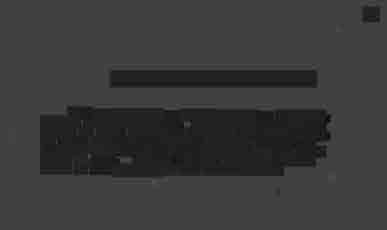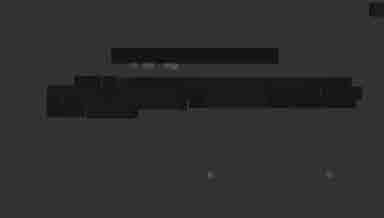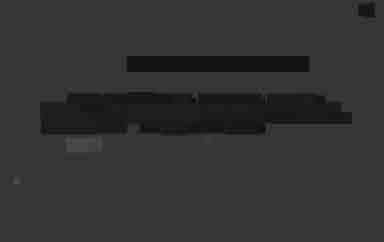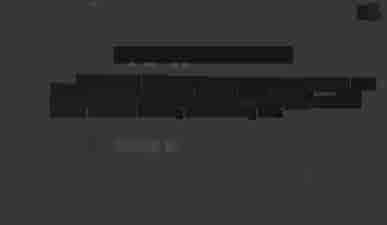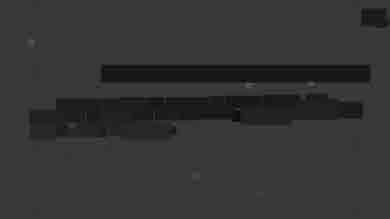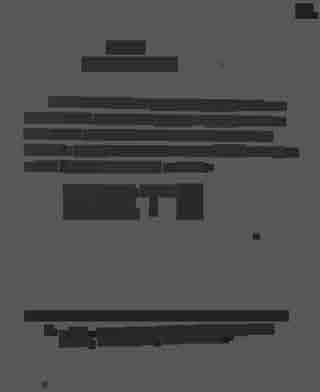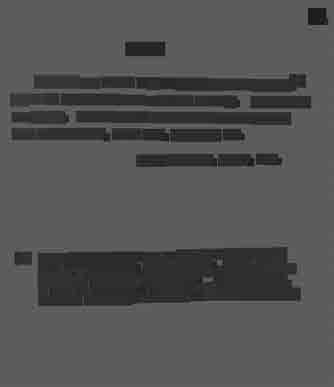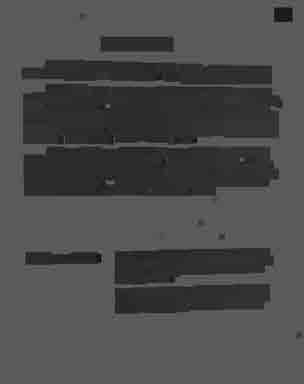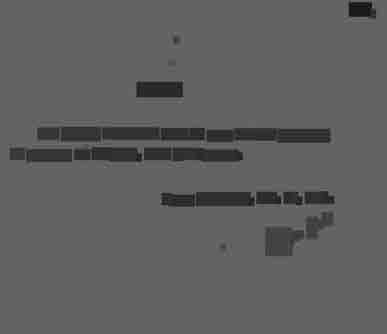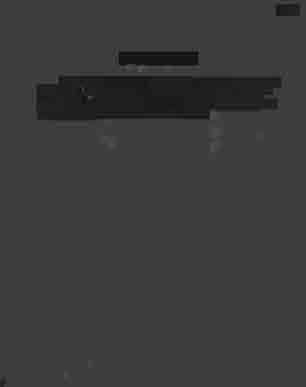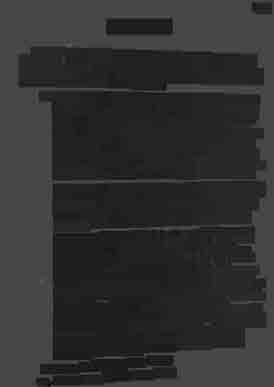Armagh MISCELLANEA
VOL.IV
Data from various sources in sequence of dates on matters relative to the city but chiefly a guide to Armagh in the 1 8th and 19th centuries.
Armachiana Volume 4
The contents of this digital resource is openly licensed via Creative Commons licence CC BY-NC
4.0 enabling reusers to copy and distribute the material for noncommercial purposes and only so long as attribution is given to the creator.
If any of the material is reproduced, in any form and in any medium, Armagh County Museum should be acknowledged as the source and the reference below cited.
Armachiana Vol1 (Armagh County Museum ARMCM.28.2014.56)
The contents of these volumes labelled Armachiana are simply notes for talks to local and visiting societies in search of material relating to its historical background and ancient monuments. They are not of any great importance but may provide a guide to students seeking data on the c ounty generally or on their own districts i n particular .
St, Patrick's Cathedral (Oldl.
Occupies a pagan site that has been in continuous use for Christian worship from the mid-fifth century •
. The shell of the present building dates back to the thirteenth century, but a frag ment of an earlier church is incorpor~ted in the present crypt. The ancient cemetery surrounding the Cathedral is the burial place of celebrated ecclesi a stics, noted warriors, and famous kings, amongst the latter that grand old warrior, Brian Boru, High King of Ireland, who was slain at Clontarf in 1014
The building was originally enclosed by the inner ring of the ancient hill-top rath, which space before the erection of the church of 1268 was occupied by three small churches whose sites are now incorporated in the present edifice.
A general restoration of a somewhat drastic character was undertaken in 1834 that resulted in all the older features becoming obliterated. At the same time the outer surfaces of the walls were encased in slabs of thin red sandstone and the interior plastered.
Cathedral contains good examples of seventeenth and eighteenth century sculpture and a collection of Regimental and Irish Volunteer banners of local interest which includes a French Colour captured at Ballinamuck in 1798 by the Armagh Militia.
Guide-book obtainable from sexton.
castle street,
An old thoroughfare built on the inner ring of the a ncient rath. Occupied by Daire in the mid-fifth century who gave Patrick a site for his second Church in the City. Name derives from a castle built about 1227 following the Anglo-Norman invasion, See Calendar of State Papers of Ireland, January 18, 1226, and January 18, 1227.
The Franciscan Friary.
Situate in Palace Demesne. Remains of a friary erected by Archbishop 0 1 Scanlon in 1264. After the dissolution of monasteries in 1542 it passed into military occu p ation for a period as barracks. Scene of several fights between the English and Irish forces. Was originally surrounded by a deep trench with strong ramparts, such protection being necessary owing to its situation outside the then city. Permission to visit obtainable on request at County Museum.
THE CASTLE OF ARMAGH,
Captain Francis Stafford to the Lord Deputy, dated January 5th, 1596,
Armagh greatly distressed for want of victuals.
Tyrone has blocked the place with a great part of his forces.
The enemy has possessed a butt end of a castle very near the great church, and hourly provokes the garrison to burn their powder.
See Cal. of Irish State Papers 1596-97, p.206.
Churches in Co. Armagh in 1600.
. A brief Survey of the County of Armagh taken before Sir Thomas Ridgeway, Knight, Vice-Treaaurer and Treasurer d o Wars in Irela nd ••••• at the Castle of Moy ry, ttie second ay of August 1608.
Barony of Or ior.
Parish church of Loughgilly wtierein the Dean of Ardmagh is person who hath two-thirds part of the tithes and a vicar who hath the third part.
Parish chur c h of To wn a ghdei lly, the tithes of the rectory belongeth to the prior and Vicars Choral of Ardmagh there is a vicar endowed.
Parish church of Killene wherein the Chancellor of Ardmagh is parson and vicar who is to place a curate.
Barony of Ardmagh.
No parish church in this barony save such as in the town of Ardmagh.
Barony of Fews.
parish church of Mullaghbrack, · the ti thee of the rectory belongeth to the prior and vicars choral of Ardmagh. There is a vicar e ndowe d.
Parish church of Kilcolman wherein the treasurer of the Cathedral Church of Ardmagh is parson and Vicar, he to find a c urate.
Chapel of Corleat belonging to the Church of Loughgilly Parish.
Church of Creggan the tithes of the rectory and vicarage belonging to the pryor and vi c ars choral of Ardmagh, they to find a curate.
Barony of O Neilan.
parish Church of Killmoore, The Deane of Ardmagh is parson in this church and the Chancellor of Ardmagh is vicar.
Churches in County Armagh in 1608.
Parish Church of Aghkillernan. The Dean of Ardmagh is parson in the Church and the tithes belong to the parson a nd vicars choral of Ardmagh.
Parish Church of Dromcreiew, the Dean of Ardmagh is p arson, the Chancellor, vicar.
Chapple of Maghery greens.
Chappell of Tarticaghan.
Parish of Shigoo, Seago a parsonage of cure a vicar endowed.
Chapple of Shanchill.
Barony of Toughrany.
Parish Church of Dirrenowes, the tithes to the rectory and vicara g e belonging to the prior ~nd vicars choral of Ardmagh to find a curate.
The Old Sessions House, Market Street.
Site now occupied as business premises by Messrs. Lennox, Martin and Sherry. The old entrance was by a flight of steps on the top of which stood the Pillory. It seems to have been built in 1619 and served as a Session House until the building of the p resent Court House in 1809. A Scold's Bridle from the Sessions House is now preserved in the Belfast Museum.
Survey of Armagh and Tyrone of 1622 .
.The Caulfeild 1 House at Armagh
Item 25. Further near unto the bawnon the outside a small river runneth, through wich a great work of lyme and stone is made that doth stop the course thereof till make a great lough, on which work is erected an extraordinary fair and good mill and doth also serve for a bridge over the river, which otherwise be impassable.
A large plot of ground very conveniently adjoining to the bawn walls is formed into a fair orchard and garden a good quantity of land near unto the house is enclosed with quicksett and well ditched. The Lord Caulfeild doth dwell there when he lieth in the country and always Sir William Caulfeild with his family doth reside upon it.
There is a small village built containing twenty houses of English fashion, inhabited all by British 1'hereof most are artificers and handycraftsmen.
The Lord Caulfeild hath built in the county of Armagh near adjoining to the town upon the side of the Abbey House a strong and convenient dwelling house of lime and stone, with a stable and other houses all environed with a bawn of lime and stone, gardens and orchards very convenient, in which doth reside one George Chambers, his kinsman, with his wife and family and fifteen English families in handsome houses, near adjoining to the said house and bawn".
The Callan Bridge, Old,
Situate on the south-western outskirts of the town. One of the oldest as well as one of the most interesting bridges in the county. It crosses the river at a point where three old roads left the town one to the north, one to the west, and one to the south
That to the south is now a "Green Road" and only traceable in part, but according to tradition it was by it that St. Patrick entered Armagh on his mission to our city, 1500 years ago, and west of 11 Patrick's Road", and near the bridge, is a Holy Well associated with the saint and a place of pilgrimage each 29th June.
Gallows Hill,
In the 17th century the road to the south left the city by Irish Street and continued out of town by a disused highway now incorporated within the Archbishop's Demesne. The scene of many executions, some of which still live in local folklore.
The Whittington House, Irish street,
Built as a private house in 1687 and remodelled in 1789. Probably the oldest dwelling in the city in continuous use. demolished 1960
Protestant Hall, Abbey street,
Site of an old city inn which housed King Jame.s the second on his way to Derry in 1689, and later gave shelter to the Duke of Schomberg, one of William the Third's most famous generals.
Old Presbyterian Church, Abbey street.
Erected in 1722 partly on the site of the ancient Abbey of St. Peter and St. Paul. Was once notable for a pair of handsome wrought iron gates, now, unfortunately, kept in storage.
The Widows' Houses, Vicars Hill.
Built in 1726 by Archbishop Boulter for the reception of four widows of clergymen of the Diocese of Armagh, and supported by an endowment provided for in his will. The locality was then known as Pound Hill in consequence of an enclosure in which stray animals were confined.
Two additional houses were erected by Archbishop Robinson in 1766, and four others in 1780, at which time he also built a spacious Music Hall.
The Mall Race - Course
March3 1731 .
A Wepresent Mr. Alexr . Livingstone as clerk of ye Course of Armagh this ensuing year and t~at the said Alexander Livingstone andb Mr ThomasOgle do collect and take up the several subscriptions 0 e P: ven by the Corporation of Armagh and others towards a Plate for whichsubscriptions the said Thomae Ogle and Alexr. Livingstone s ha ll account upon oath before the Sovereign and Grand Jury of said Corporation when required .
. . We present William 11 English the said Thomas Ogle and Alexander Livingston to regulate and fix the prices for the standing of each booth on the said Course as well of the inhabitants of the Corporation and all others .
June 1 5 1 1752 ,
By the consent of the Grand Jury of the Corporation of Armagh it ; e agreed that a sufficient sum be raised on the security of the Corporation and Grand Jury or a suffici en t number of them jointly wi th Thomas McCan of the Town of Armagh, gent, and interest paid yearly for the same till such principal sum is discharged .
And that the said sum shall be laid out and applied 1n enclosing that part of the commons of said Corporation' lying withi n the circle of the Course, leaving sufficient room for a course without ·said enc lo sure and the same to be enclosed with a ditch eight feet wide and.. quicked with good white thorn quicks forthwith and that three or four sufficient gates be erected on eaid Common one at such end and a third or fourth in the midd le .
It being agreed by the said Ju ry and preeented by them to be a nuisance in the state and condition it. is now in and that the same when enclosed shall be kept and preserved by said Corporation and Grand Jury thereof for the time being for meadow and that the hay of the said meadow shall be yearly disposed of by persons authorized or appointed yearly for that pu r pose and the profits accruing from such Commons either by s aJ e of said hay or grass shall be applied in the first place to the discharge of t he s a id principal and interest until said principal sum and interest be fully paid off and discharged and from and after the discharge of the said principal and interest the profits thereof shall be applied to the uee of the said Corporation and that said common be kep t and preserved by them and not set or demised to any person whats oever.
Jenny's Row, Upper English Street,
A quaint little thoroughfare leading from English Street to the Mall and much in use before the opening of Russell Street circa 1836 Takes its name from the Rev. Henry Jenny, Rector of Armagh in 1738 in whose old shingled house, now the Beresford Arms Hotel, the famous Dean Swift was a~ times an honoured guest.
ll English street 1~ '-J Beresford arms hotel was bombed on 1972 destroyed ,(.c..r0-- closed '-> f,..J. It was re- opened as a bank f,r-...J 1993 Bank Ireland
Drelincourt School, Navan Street,
Erected in 1740 by Mrs. Drelincourt, widow of a former Dean of Armagh. An interesting mid-eighteenth century building. Unfortunately partly hidden from view by a high wall. Not open to the public.
(J'1 Burnt -,._
,,._
ARMAGH.
Freemen's Lists. Clockmakers 1742-60.
27 Sept. 1742. John Williamson. Clockmaker.
22 Sept. 1743. Thomas Kennedy. do.
28 Sept. 1744. Char le s Hi r ,dman. do.
10 Oct. 1760. Alex. Waugh. do.
Alex. Waugh had the care of the town clocks from 1777 to 17 8 5. I n 17 8 6 the Widow Waugh and James, son of Alex. ap p ear. James Waugh 17 87 -1 800 . ·
In Stuart's "Memoir of Ar magh" (p.523) it is stated that a transit i n stru me n t was made for the Observatory by Mr. James Waugh, a very ingenious mechanic and a native of Armagh. It is highly creditable to his talents and after having been used mo s t successfull y for 25 y ears is still in use. He also assisted in the making of an astronomical qua dra n t .• Ibid p.525.
Myles Stayplton, Clock Maker, Armagh.
See Return of Artificers within the realm of I re land 1622.
This is the earliest record of a clockmaker that I have four in connection u:i. th the City of Armagh. (T.G F P )
Beresford Arms Hotel,
The Beresford Arms commemorates Lord John George Beresford, a princely Archbishop of Armagh. His family arms in true heraldic colours were sported by the hotel within living memory, but alas! the old sign has now been discarded. It has, however, recently been replaced by a painted hanging sign. The hotel, however, goes back far beyond the Archbishop's time. In the days when English Street was chiefly residential it housed Dr. Henry Jenny, Archdeacon of Armagh and Rector of the parish from 1738, until 1758, hence the name of Jenny's Row for the little laneway at the side. Shortly after his death it was taken over as an hotel. In the Irish Volunteer days it was a place of consequence and known as the King's Head Inn. Local companies dined there in 1779, and in 1784 the Earl of Charlemont, Commander-in-Chief of the Volunteers reviewed the Armagh Regiment and some companies of County Down Volunteers from its windows. Its host was then a certain George Parks, an ardent Volunteer. In 1792 he sold the premises to a Charles McReynolds, who in 1793 changed the title to the Molyneux Arms in honour of a notable local Volunteer, Sir Capel Molyneux Bart. McReynold's tenure of the premises was short. From the Alexander Hamilton Diary we learn that he was buried at Stewartstown on August 13th, 1796, and that the funeral was attended by a great body of horsemen in scarfs and hat bands and a great many carriages, all the Armagh hackney carriages, and a coach. Some time later the hotel became the "Royal Hibernian" and so remained until it received its present name sometime after 1822.


St. Malachy•s Chapel (Old), Chapel Lane. 1752
Erected 1750. Situate almost on the same spot as the fifth-century Church of St. Brigid. Commemorates a famous Archbishop of Armagh, born in the city in 1094, and since canonized as a saint. The site of his birthplace marked by a tablet in Ogle Street nearby. Building closed to the public because of faults in the structure.
ARMAGH.
Food Inspection. 1757
en Thursday, 20th, Thomas Ogle, the Worshipful Sovereign of the Corporation of Armagh, attended by Overseers, visited the butchers and other markets and took up -
Five quarters of blown mutton. Two ligh t sixpenny loaves. Two pounds of candles deficient in weight.
all of which were d istributed to the debtors in the jail and to the Poor House Keepers. With like diligence he hath frequently taken up and condemned quantities of fleshmeat, bread, butter, unsound herrings, etc. - also beams and weights for being false.
Belfast Newsletter 30 December, 1757.
ARMAGH.
Food Inspection. 1758
Thomas Ogle, Worshipful Sovereign of the City of Armagh took up on Tuesday, 27th June -
Twent y -two loaves of light bread
Six p ounds of light and unmerchantable flax, etc.
See Belfast Newsletter 11 July, 1753. A further i n spection on 18 July of same year.
Journal of the House of Commons, Geo.II, p,236. (Vol.XI).
Your Committee proceeded to enquire into the application of the sum of five thousand pounds granted to the Incorporated Society in Dublin, for the encouragement of English Protestant Schools in Ireland, to build one nursery in each province in this kingdom, for the reception of one hundred children, under the age of six years, in each nursery.
Thomas Gibbons, Clerk to the said Society, laid before your Committee an accompt, by which it appeared, that the said Society had received four thousand eight hundred and fifty pounds, £4850 net, and had paid to Robert French, Esq; for Monivae nursery one thousand and seventy seven pounds, six shillings and eight pence; to the Earl of Drogheda eight hundred pounds for Monaster - even nursery; to William Bury, Esq; eight hundred and eighty three pounds, fourteen shillings and eleven pence,for Shannon - grove nursery; to Henry Meredyth, Esq; two hundred pounds, to be paid to Henry Cust Esq; for his interest in six acres of ground, which were purchased for the use of the nursery intended to be erected at Armagh (1)and that a ballance of one thousand eight hundred and eighty nine pounds, five shillings and a penny, is in the hands of the treasurer of said Society; as by said accompt hereunto annexed.
Ibid, p.338,
By cash paid Henry Meredyth, Esq; to be paid over to Henry Cust, Esq; the consideration money for his assignment to the society, of his term and interest for forty years to come, of and in six acres of land, adjoining to the town of Armagh, for the use of the said nursery, intended to be erected there
£200 0 0
(1) Hence the name "the Nursery still in use for the property between the Killylea road and the old Callan bridge at Navan Street . It has also beenknown as Pentonville because of its association with the Penton family.
Armagh Nursery.
Pentonville EN T O N VI L L E Nursery R SER Y, ARMAGH.
GEORGE PENTON offers for Sale several million of Transplanted and Seedling FOREST TREES, of all sorts and ages, which cannot be surpassed in this Kingdom, at very Reduced Prices.
He has also a large assortment of FRUIT TREES, consisting of PEACHES, APRICOTS, NECTARI NE S, PEARS, PLUMS, CHERRIES, &c., both Standard and Dwarf, and a large collection of EVERGREENS, FLOWERING SHRUBS, AMERICAN PLANTS, ROSES, &c.
G. P. has also received from London~ large supply of GARDEN AND AGRICULTURAL SEEDS; among the New Seeds is the TREFOLIAM INCARNATUM, or WINTER CLOVER. His Seeds are all of the best quality, and will be Sold at unusually low Prices,
Seakale ASPARAGUS, and RHUBARB PLANTS.
All orders carefully attended to, and forwarded with expedition , Newry Examiner, March, 19, 1834.
GeorgeE O R O E
PentonE N T O N, NURSERY AND SEEDa-iAN, AR M AG H,
OFFERS for SALE, several Mi llions of Transplanted and Seedling FOREST TREES, of very Supe rior Quality, which cannot be surpassed in this Kingdom, at Reduced Prices. Also, a very Extensive and Choice Assortment of FRUIT TREES, consisting of Peaches Ap ricots, Nectarines Pears, Plums, and Cherries, Standard and Dwarf and a Large Collection of Evergreens, Flowering Shrubs, American Plants, Roses, &c,, &c.; Sea Kale, Asparagus, Rhubarb, and Waterloo Caesarean Cow Cabbage Plants, G. P. has received from London a Supply of EARLY GARDEN SEEDS, suited for the Season, Winter Vetches, and Dutch Flower Roots, Catalogues of Prices may be had at his SEED-SHOP , THOMAS STREET.
October 4, 1836. Newry Telegraph.
THE ARMAGH NURSERY.
New GARDEN & AGRICULTURAL SEEDS.
PENTON & CO., 36, North Street, Belfast, and Thomas Street, Armagh.
In returning their sincere and grateful thanks for the very liberal encouragement they have received since their commencement in Belfast, beg to assure their Friends and the Public, that it shall be their constant endeavour, by unremitting attention, and keeping every article of the best quality, and at unusually Low Prices, to merit a share of their future aupport. They have now to announce the arrival of their SPRING AND SUMMER STOCK OF GARDEN AND AGRICULTURAL SEEDS
For both Houses; all of which have been procured from the best quarters, and selected with great care, and comprise every article in the Vegetable line, as well as a choice and beautiful collection of Flower Seeds. Their supply of
AGRICULTURAL SEEDS
Is varied and extensive, and of the very best description, including every variety of Field Turnips, and Carrots, Mangel Wurtzel, Spring Vetches, Red and White Clover, Trefoil,
Perennial Clover or Cow Grass, Italian, Perennial, Timothy, Cocksfoot, Foxtail, and all the other Grasses in cultivation.
Several varieties of superior SEED OATS and Early Seed POTATOES.
In the ARMAGH NURSERY there are several Hundred Thousand FOREST TREES, which, having been twice transplanted, growing in an exposed situation, and being well rooted, rendering them more valuable to the Planter, they can With confidence recommend.
Also, a large stock of ORNAMENTAL TREES, FRUIT TREES of every description, Trained and Untrained EVERGREENS, FLOWERING SHRUBS, AMERICAN PLANTS and ROSES, Green-House PLANTS. A choice collection of
Four Millions of Fine THORNS, ASPARAGUS , Sea KALE, RHUBARB, and other Culinary PLANTS, MUSHR OOM SPAWN, BASS MATS, GARDEN IMPLEMENTS, and every other article in the NURSERY and SEED Business.
All orders punctually attended to, and forwarded w1th care and expedition,
Those in the seed Trade supplied on the mo st advantageous terms
4th February, 1845
The Post Office,
The first Post Office that we have a record of was situate in Market Street and its position is clearly shown on Rocque's Map of 1760. Its position was, however, frequently changed in the following century but, eventually, found a settled location in English Street in
The gateway of a h ouse on the north si d e of the Post Office with which it is now incorpor a ted contains a keystone dated 1840.
The Stone Bridge. Richhill.
It is commonly assumed that the district derives its name from the group of stone bridges built about a century ago to carry the railway across the river and road. The designation, however, dates back to at least the mideighteenth century and there is a tradition that it arose through the building of a bridge at a spot on the river which in old days was a ford, by some member of the Richardson family. At anyrate the place is shown on Rocque's Map of 1760, and it is evident that lands on both sides of the river were so known long before the days of railways - for instance the Belfast Newsletter of March 24-27, 1797, carried an advertisement as under:-
"To be sold on 10th April next, at the house of William Stewart of Stone Bridge, forready money only, his commodious farm of 18 acres ••••••• Within one mile of Richhill, five of Armagh, five of Tanderagee and four of Portadown
Charlemont Arms Hotel.
The Charlemont is a place of some antiquity and derives its title from the famous Volunteer Earl of Charlemont. In the heyday of the Irish Volunteers there was a Charlemont Arms in every town of note, now there is probably not another surviving in the whole of Ireland.
Originally the licensed portion of the present premises were known as the 11 Caulfeild Arms 11 , Caulfeild being the family name of the - Viscounts Charlemont. When James Caulfeild, the 4th Viscount, was created an Earl in 1763 and later became so notable a figure in public affairs, the designation was changed so that travellers passing through the city might be suitably impressed with its importance. The hotel proper was, however, in those days the residence of Dr. Atkinson, a member of the family long settled at Crow Hill.
ARMAGH CANAL,
In 1761 an estimate of the expense of making a canal from the Blackwater near Ballycullen Bridge above Charlemont to the Scotch Street Bridge at the town of Armagh ••.••
See Journal of the Irish House of Commons 20th Nove mber 1761, also 25th February, 1760, for reference to sum paid to' Thos. Ashmore for taking the level from Armagh to Blackwater and drawing a map of the same.
A later effort was made to extend the Ulster Canal to Armagh City in 1843, The canal would have left the Ulster Canal where it passes from Mullyleg g an to Tireagerty, on the left of the road from Armagh to Blackwatertown; here it would have been on the same level as the canal and would have been run through Mullyleggan and then across a corner of Drumcullen into ·Creaghan, cutting across a corner of this townland Tirgarve would have been entered and about 250 yards further on the by-road to Armagh via Todd's Corner crossed, Just on the Armagh side of this road the first lock was to have been built after which s stretch of about one third of a mile would reach the second lock in a cutting in Killylyn behind where the Blackwatertown road joins the Moy Road, For the second lock the corner turned more towards Armagh should pass across the southern edge of Allistragh to the third loc k about 100 yards from the main road to Moy It was to be crossed near the Beetling Mill, then the course was along the mill race to below the weir. Here the Callan bends in towards Drumsill House and a new course of the river was proposed along the shortest path and the canal would have passed the dry bed of the river twice and then gone on to the fourth lock about 300 yards further on. The Callan course was then followed through Drumcairne to where the river makes a sharp bend southward and here it was to be again crossed. The line then crossed the Loughgall Road near where Wilson's mill now stands. A deep cutting was to be made here after which the canal crossed the site of the present station and ended in a harb our behind where Railway and Edith Terrace are now built.
The reservoir was to have been constructed behind the Deanery on the Dean's Bridge river where it approaches the railway station from the meadow lands. This reservoir would have kept up the supply of water to the Canal. The full length of the canal was to be 4½ miles and the harbour was intended to have been another 300 yards or so in length which would have brought it up close to Lisanally Lane. The construction of the railway from Belfast and later the line from Newry killed the project.
This would have enabled Armagh to have brought up its coal, timber, iron, flour and heavy goods from Newry and Belfast by water at a low rate as . compared with the heavier railway charges.
Before the advent of the railway Blackwatertown was a very busy place. Li g hters came up the Blackwater river from Lough Neagh laden with provisions, timber, slates and other goods which were afterwards carried by road and distributed over the adjoining counties of Armagh, Tyrone and Monaghan.
Methodist Church, Abbey street,
Following Wesley's first visit to the city in 1767, a society was organized that quickly increased in numbers. It first met in a house in Thomas Street but in 1786 a church was erected in Abbey Street near the spot where the great evangelist preached his first sermon in the town. That building was replaced in 1835 by the present edifice.
The Presbyterian Manse, Abbey Street.
Erected in 1767 by the Rev, William Campbell, D.D., a former minister of the 1st Presbyterian Congregation of the City of Armagh, and an ardent Irish Volunteer. Re-roofed by the Rev. Thomas Cuming in 1807 and renovated in 1818 by the Rev. Alexander Fleming. After occupation by various private families it is now the Planning Office for the County of Armagh, Demolished 1968
The seven Houses, English street.
Built about 1768 by the Very Reverend John Averell, D,D, (later Bishop of Limerick) for his seven sisters. Good examples of the country town-house of those days with fine rooms, spacious stables, coach-houses, etc.
Archbishop's Palace, Palace Demesne.
Erected 1770 by Archbishop Richard Robinson who seven years later was created Lord Rokeby of Armagh. Architect the celebrated Thomas Cooley. Contains a fine collection of portraits of Archbishops of Armagh from the days of Queen Elizabeth to date, besides many royal portraits by eminent artists.
A second storey was added in 1822 by Archbishop Lord John George Beresford, to the design of Francis Johnston, a famous Armachian responsible for a great number of Dublin's finest buildings, and for castles, mansions and institutions . throughout Ireland generally.
Not open to the public.
The Public Library, cathedral Hill.
Founded by Archbishop Robinson in 1771 and built to the design of Thomas Cooley, but has since been enlarged. Contains fine collection of books and manuscripts and is the home of the City Maces and Corporation records besides medieval registers of the Archbishops of Armagh and other treasures. Open daily Mondays to Fridays 11 a.m. to 1 p.m. and 2 p.m. to 4 p.m. Saturdays 11 a.m. to 1 p.m.
Dean's Hill.
Now the residence of the Armstrong family but originally a seat of the Deans of Armagh
Built in by the Rev. Hugh Hamilton, Dean of Armagh 1768-1796, who,in the latter year,was consecrated Bishop of Clonfert and three years later was translated to Ossory where he died in 1805.
His son, Alexander, left an interesting diary covering the eve n ts of 1798, and the fa mily gave name to the present vill a ge of Newtownhamilton.
1 7 7 2
DEAN'S HILL
1768.
Dr. Hugh Hamilton was appointed Dean of Armagh in Following his appointment he built a very good house and offices upon the demesne of Tullydegney which was first inhabited in 1772. Dr. Hamilton was born in Co. Dublin in 1729, entered T. C. D. in 1751 and obtained a Fellowship in 1796. In 1776 he effected a deed of endowment of the parish of Grange.
Record of the City of Armagh from the earliest period to the present time. Vol.III, p.303.
See also Leslie ' s "Armagh Clergy and Parishes" under Deans of Armagh.
The Military Barracks, Barrack Hill,
The first military quarters in the city seem to have been the Castle of Armagh, a building erected about 1227, fro m which the present Castle Street derives its name. The first military barracks built and planned as such were erected in 1736 on ground now partly covered by the prison. They were removed to the present site in 1773 and have at various times since been renovated and enlarged. Now the Depot of the Royal Irish Fusiliers. Regimental Museum open to the public.
The Royal School, College Hill,
Founded by King James the First in 1608. Removed from old site in Abbey Street to present position in 1773. An example of the work of Thomas Cooley, a celebrated 18th century architect. School roll incorporates the names of many famous men, peers, bishops, generals, admirals, etc. Not open to public.
Whaley's Buildings, Castle street.
Erected 1773. Note decorated urn. The Whaley family (of whom the celebrated Buck Whaley was perhaps the most famous member) were at that period in occupation of an extensive property in the city and vicinity mostly held from the See of Armagh.
The County Infirmary, Abbey street.
Erected 1774. George Ensor, architect. A pleasant facade but somewhat spoiled by the insertion of plate-glass lights in place of the original small panes.
Provincial Bank, Upper English Street,
Originally the home of Robert Livingstone, Agent to the 1st Earl of Charlemont, and a special friend of the famous John Wesley. A lintel-stone survives marked R.L. 1774 Livingstone died in 1821 and the house was later purchased and rebuilt by the Provincial Banking Company. Allingham, the poet, was for a short period a clerk in the establishment.
The Metropolitan Registry Office, Vicars Hill.
Erected by Archbishop Robinson in 1776 as a repository for ecclesiastical d ocuments and registers a ppertaining to t h e See of Armagh.
Palace Row Entrance Gates, Archbishop's Demesne.
Erected in 1780 to designs of Thomas Cooley, the architect responsible for the Palace, Royal School and the Public Library
The Prison, The Mall,
Built in 1780 to replace the seventeenth century gaol in Market Street so celebrated in local tradition because of its connection with certain famous highwaymen and outlaws. Site of earlier prison now occupied by business premises.
County Infirmary.
For the benefit of the County Infirmary there will be an Assembly at the Market House of Armagh on Thursday 18th May next and also 15th June, 13th July ., 13 August, 15th S eptember, and 12th October, being the Thursday in each month nearest to the full moon.
Subscriptions to all six Assemblies - a gentleman three crowns, a lady half-a-guinea. Non-subscribers to pay each night 3/3 and a lady 2/8.
Printed notices not to be sent round for each Assembly as formerly.
B.N.L. April 28 1 1780.
Profits from Assemblies appears in Infirmary Accounts under date 9 'Oct, 1766, to 7 August, 1771, and 7 August 1771 to l July, 1775. Amounts show respectively £35.5.9. and £121.18.3.
Palace Chapel, Palace Demesne,
Designed by Thomas Cooley in 1781 for Archbishop Lord Rokeby but completed by Francis Johnston in 1781-82. Not open to public except by permission of the Archbishop.
The Obelisk, Palace Demesne.
Designed by Thomas Cooley but completed by Francis Johnston. Erected in 1782-1783 by Archbishop Lord Rokeby to commemorate that Prelate 1 s friendship with the Duke of Northumberland, a former Lord Lieutenant of Ireland 1 through whose influence he was translated in 1765 from the See of Kildare to the Archbishopric of Armagh.
TOBACCO AND SNUFF MANUFACTORY.
John Singleton of Armagh begs leave to inform his friends and public that he has commenced the tobacco and snuff manufacture and that he is now ready for sales at his stores in Armagh and has extensive assortme n ts of roll tobacco and snuff.
B.N.L. December 27, 1783.
ARMAGH .
Local Silversmiths
In the late 18th and early 19th century there were certain local silversmiths working in Ar magh of whom we have little information other than that contained in Jackson ' s " English Go l dsmiths and their Marks 1 which gives a list (probably incomplete) as under :-
Michael Scu l ly , Armagh , Thomas Simpson " James Sco tt " John Wi l liamson "
1 784 . 1784. 1787. 1796,
1. p674 - under "Names of Irish Provincial Goldsmiths, Silversmiths, and Jewellers .
The Observatory,
Founded by Archbishop Robinson in 1789. First Astronomer appointed 1790. Francis Johnston, architect. Planned by its founder as part of a design for the revival of Armagh as a university town. Open to the public on application beforehand to the Director.
The Mallside Cafe Barrack Street,
Built in 1791 as a private house by Samuel Johnson, member of a family long settled in Armagh.
ARMAGH Dispensary
A Number of the Inhabitants of Armagh and its Vicinity, have entered into a Subscription for the purpose of establishing a Dispensary, to assist the sick Poor with Advice and Medicines to open on the first of February next, under the care of the Physicians and a Committee of the Subscribers. As this Institution is intended for the relief of the sick Poor from every Part of the County, who shall be recommended by a subscriber, and who are not admittable as Patient s into the Public Infirmaryand as it will be conducted on the most liberal Plan that the Fund will permit the Subscribers solicit the admittance of the Gentlemen of the County at l a rge who will no doubt be forward in contributing to so extensive and benevolent an undertaking. by Annual subscribers and Benefactors will be received
The Rev. Dean Hamilton, Dr . King, Dr. Macan, Dr. Atkinson, Dr. Simpson
The Re v. Thos. English, Messrs. C. Gen.Whittington, Murray, Thos. Prentice, or John Dobbin, Sec.
"From Number 5780 of the Belfast Nows-Letter, Deer. 28 to Jan 1 1793 and repeated in Numbers 5781 & 5782 •
ARMAGH OBSERVATORY,
Armagh Observatory was established in the closing years of the eighteenth century, which was a period that saw the creation of many such institutions both on the continent of Europe and in the British Isles. The patronage of King George III, who built and furnished the Observatory at Kew in 1769 the success of William Herschel later, and the invention of' the achromatic telescope may have been causes contributory to the vogue for astronomy that apparently existed at that time. In 1760 the Glasgow University had its beginning; the Radcliffe Observatory at Oxford was built in 1772; the Observatory on Calton Hill, Edinburgh, in 1776. Provost Andrews, of the University of Dublin, bequeathed a substantial sum for the foundation of an Observatory which came into existence at Dunsink about the year 1785, and a few years later than that Richard Robinson Archbishop of Armagh, provided land as a site for the buildings and a larger quantity as endowment for an Observatory which was to form an item in a university ~or Northern Ireland, whose foundation he envisaged but which was not realised
"Armagh Guardian" February 5. 1937. auoted from n The Times".
The Swimming Pool, Folly Lane,
Originally known as "the Basin" and the source of our first water-supply, an amenity made possible by a bequest in the will of Lady Primrose wh o died in 1775 ,
A small tract of ground was obtained in 1793 at the head of Folly Lane and converted into a reservoir designated "the Basin" which with the filtering bed now constitutes the Armagh Swimming Baths,
The then water supply came through wooden pipes, sections of which are still found from time to time in the older ·parts of the town during excavations.
Lady Primrose was the daughter of Dr. Peter Drelincourt (Dean of Armagh 1691-1722), and widow of Hugh, 3rd Viscount Primrose.
The Pound, Prison Lane
In the 17th century the City Pound was situate on Gallows Hill, but was later removed to a site near the Cathedral which then became known as Pound Hill, but is now named Vicar's Hill.
In 1806 the Pound was removed to its present situation in the lane east of the Prison where it still remains and is probably the only example surviving in any city in Ireland to-day.
COCKFIGHTING.
Coagh. Cockfighting. Counties of Armagh and Tyrone 50 guineas the main or odd battle. N.s. June 29, 1795.
COCKFIGHTING.
To be shown on s instant, and f Ol.lght Saturday • the 20th day of Marcheh Moira , a main of 3 1 weak followi ng in the tow n of one hundred guineas th~ks for four guineas a battle and county of Armagh and main or odd battle between the the County of Antrim.
B.N .L. Ma rch 9 1 1779.
one to be shown at Lurgan, the 22nd instant, thirty of Armagh and fifteen bye-battles, between the gentlemen ma·n e ounty of Down for 100 guineas the 1 or odd battle and to be fought on Monday , 24 inst.
B.N.L. May 10 1 1779.
To be shown in Moy in the County of Tyrone on Saturday, 12th June, between the gentlemen of the cou n ties of Tyrone and Armagh, 31 cocks for 10 guineas the battle or 100 guineas the main.
B.N. L. June 17 1 1779.
The Royal Sport of Cockfighting. To be fou g ht a main of cocks i n Portadown between the gentlemen of An trim against Armagh and Down for 500 guine as the main or odd battle and 5 guineas a cock. To be shown on 29th April and fought on Monday following.
B.N.L. Apr il 4 1 17 8 6.
Cockfighting at Ardmillan, 31 stags and 21 cocks. Gentlemen of Down ve·rsus Gentlemen of co. Armagh. 50 guineas the odd or main battle.
N.S. April 18 1 1792.
Antrim against Armagh. A main of 31 cocks will be shown at Dromore by the above counties on Saturday 4th April and fought ensuing week for 100 guineas.
N.s. March 26 1 1795.
The Gooseberry Gardens 1800.
These contained arbours and were a place of assembly from May to October but more especially so in the season of the g ooseberries - hence the name. They contained a circle of standing stones which served as a place of e ntertainment for small boy s and girls who played hide and seek amon g st them. A small charge was made for admission a n d it see ms that there were other fruits obtainable also in their various seasons.
The site is now occupied by the Gas Wo rks and ' the building of he circle of stones was demolished and the gardens obliterated.
There was more Gooseberry Gardens at the back of the Prison and they are portrayed in Black's sketch of Armagh, painted in 1810.
The Flag Meadows.
Circa 1800.
A tract of meadow land extending from the back of the Courthouse to the Asylum ground. It seems to have been so called because of the wild irises that formerly grew there in great profusion.
The Pavilion.
Erected circa 1809~ Entrance at foot of College Hill and from east side of Court House. Note contemporary period lamp-standards and railings at gate-lodge. Not open to public.
K Probably earlier. Built by William Whitelaw Alego of the 82nd Foot. He married Margaret Livingstone of Armagh at Armagh Cathedral 1 May 1804 and erected the house shortly afterwards. His wife was the second daughter of Robert Livingstone the then agent of the Charlemont estate in which post he was later succeeded by his son-in-law.
Mr. Livingstone died at the Pavilion 20th June 1821 aged 86 years. He had previously lived in an old house at the bottom of Abbey Street. Its site is now covered by the Provincial Bank.
Captain Alego came from Manorhamilton and died
The Court House, The Ma11,
Built in 1809 to replace a seventeenth century Sessions House in Market Street, Francis Johnston a rchitect. Note Fire Marks in position on each side of main entrance, Fire Marks and Fire Plates are becoming exceedingly rare. The earliest types were made of lead, those constructed of copper being secondary in point of age, Later they were struck in cast iron and other metals. Each Fire Office possessed its own particular "Mark" and in the beginning of the system firemen belonging to individual companies could only assist in quenching such fires as were covered by their Company's "Mark" or "Plate",
The Court House has.. a very dignified interior and the Council Chamber and Barristers• Room each have pleasant but simply decorated ceilings. Not open to public unless by permission. Courthouse bombed (1000lb) 3-9-93 much altered CMcC
The Windmill, Windmill Hill.
Site of a Windmill in the 17th century, and a mill shown on Rocque' s Map of the City in 1760. Present mill occupies same site but was rebuilt in 1810.
The Association for the Relief of Sick Poor and Distressed Room Keepers
See Corporation Records.
Beresford Row, The Mall. (East side).
Erected 1810, 1820, 1835. Note balconies and fanlights.
st. Mark's Church.
Built in 1811 as Open to the public. of a Cooley design. Grange.
a Chapel of Ease to the Cathedral. Possibly a Francis Johnston adaption Compare tower with Lisnadill and
Royal Hotel, Dobbin Street.
Said to have been erected in 1811, but ground- plan of building is shown on Rocque's Map of 1760. Datestone probably refers to the opening of Dobbin Street. Note door-case and fanlight. Altered window-lights and modern concrete facing spoil an otherwise pleasant building. In the pre-railway days one of the chief hotels of the town
Bank of ireland scotch street,
A very dignified example of an early nineteenth century house with interesting contemporary ironwork, including grille-work lamp-standards of local craftsmanship, and decorated ceilings bearing the Dobbin crest. Erected in 1812 by Leonard Dobbin Member of Parliament for the Borough of Armagh 1833-1838, Francis Johnston, architect. Occupies the site of Templenafertagh, St. Patrick's first church in Armagh, Reputed burial-place of the saint and his sister, St, Lupita.
BANK OF IRELAND HOUSE.
This house was t 8 erected in 112 by Leonard Dobbin, member of a local family long associated with the city and neighbourhood of Armagh, A year earlier he built the rather charming crescent-shaped street we now know as Dobbin Street, a thoroughfare now alas greatly disfigured by ill-adapted efforts in modernization. For his architect in those two projects he chose his old friend Francis Johnston , then one of the most distinguished members of that profession.
Dobbin who was born in 1762 was a Deputy Lieutenant for the County of Armagh, served as Member of Parliament for the Borough of Armagh from 1833 to 1838 and died unmarried in 1844. His portrait painted by Martin Creggan a celebrated Irish artist, is preserved in the County Museum.
An earlier Dobbin house occupied the same site which is of great local interest, being in fact the location of St. Patrick's first church in our city, the burial place of his sister Lupita, and the probable resting place of the saint himself,
1 8 1 1815
Eng r a ved map of the City of Ar magh by James Donnelly (1)
Ma p to be embellished with a view of the city . Subscription one guinea . Subscribers to date inc l ude Francis Wi l l i am , Ea rl of Charlemont, James Iles , Sovereign , etc .
Newry Telegraph , July 4 , 1815 .
( 1 )
architect and living at James Donnel l y ab ove was~ 18 39 He was one of No . 8 College Street , building of Gosford Ca stle Hopper ' s assistants~ ear I have not seen which was completed in ~ha year that the subscribers a copy of above map i m~y s to warrant pub l icat i on . were not sufficient in num er
The Market House, Market street
Built in 1815 by Archbishop Stuart and now in use as a Technical School. Armagh is an ancient market town but the date of its first Charter is unknown. It was, however, a market town of some standing in 1468 when Edward the Fourth granted a new Charter to the then Archbishop. According to an Inquisition taken in 1609 11 A weekly market had been held in the town time out of mind 11 , so a further Charter was granted by King James the First, by which the city became a Borough and returned two representatives to the old Irish Parliament. Site has been occupied as a Market House for at least three centuries, and the building sits on the outer defensive ring of the ancient hill-top settlement. Francis Johnston may have been the architect.
On Wednesday last 6 prisoners escaped from Armagh gaol. They had lifted a flagstone in the privy in the Criminals' yard and, descending into the sewer, passed under the gaol. Five of them, having contrived to take off their bolts, effected their escape. The sixth was taken in the barrack field, with his bolts on, by some soldiers of the 42nd Regiment. Two of them were sentenced to death for a burglary, but had that sentence, we believe, commuted for banishment.
Freeman's Journal. Friday, August 1st, 1817.
ARMAGH PRISON. 1817
MACAN ASYLUM FOR THE Blind
Arthur Jacob Macan died in India 18 September, 1819, and by his will of 6th June of that year made provision for the foundation and endowment of an Asylum for the Blind in the City of Armagh 11 open alike to all religious persuasions and free fror:i all discipline offensive to any; yet strongly inculcating sound morals and enforcing attendance at their respective places of worship".
The resident Burgesses of the city with the Dean of Armagh, the Presbyterian Minister and the Parish Priest assisted by three citizens, one Episcopalian, one Presbyterian and one Roman Catholic, selected by each sect to act as Governors.
under its constitution the blind of county Armagh were to have preference, and its inmates were to be encouraged in crafts whereby they might help to earn a living. Deaf and Dumb were to be added if funds permitted.
Report on Municipal Corporations 1835.
Ulster Bank, Upper English Street.
One of a group of two houses erected by William and Thomas McWilliams in 1820 on the site of a couple of much earlier habitations. The architect was John Quinn and he produced a pair of very dignified houses with delightful door-cases and fanlights. Those amenities have, however, since been removed both in the Bank and in the business premises of John M. Wilson.
House of Industry. 1820
The House of Industry, Thomas Street, 18 2 0 .
Beadles ordered to be in constant attendance and that inha b itants will send for them should they be an n oy ed by vagrants or beggars.
The "Poor Cart" for "broken meat" will be sent round on Mondays, Wednesdays and Saturda y s, fro m ten until two o'clock and a bell will be attached in order to warn the citizens of its approach.
By Order, July 1820. c. Foster, Secretary.
Linen Ha11, Dobbin street,
Opened in June 1820 at which date Armagh was a very important linen centre. In recent years was in use as Butter and Egg Market, but is now derelict. Has handsome grille-work lamp standards of contemporary date. Dobbin Street, built in 1811, is a crescent-shaped terrace of much interest. The Clock Tower and very dignified entrance from Linen Hall Street are said to have been erected from the designs of Francis Johnston.
THE LINEN HALL,
A brown Linen Report of 1822 states that the above hall was opened in June 1 820 - see Appendix, p . 175 .
From the same source we learn that "there has been a convenient walled in Market lately erected by His Grace, the Lord Primate . The Sovereign of the city has always been particularly attentive to the interests of the trade and attends every market to . hear and decide on complaints arising from it " - see account of meeting in Armagh, Tuesday, 31st July , 1821 - ibid p . 109 .
A Yarn Hall was erected in same street in 1820 by Leonard Dobbin, afterwards M. P . for the Borough . It is now (1953) covered by Bradford ' s Egg Stores in which the old date - stone i nscribed "Yarn Hall 1820 is pres:irved in an interior wall. An account of the Yarn Hall will be found in Stuart ' s Memo i r of Armagh p . 514 .
(Notes on above :
The Li nen Market enclosed and Clock Tower built by Archbishop Stuart who had some years earlier erected the Ma r ket House .
Th Clock Tower and gateway leading Abbey Lane are said to have both been designed by Francis Johnston .
The orange Ha11, The Ma11,
Built as a school in 1818 by Archbishop Stuart. Rendered obsolete by the grouping of most of the local primary schools in one institution circa 1928, and later sold to the Orange Order. Francis Johnston is reputed to have been the architect and the edifice certainly sug gests a kinship with certain schools designed by him in other parts of Ireland.
ARMAGH COUNTY Mental HOSPITAL.
Armagh Lunatic Asylum take of District en over the Local Cssrs; B f . t ylums for Lunatic Poor on December 10 1824 e ore i was opened lu n a t ics were s e nt t o t he res ~ctive· prisons for their districts for detention and treafment and one of the amusements was "going to see the lunatic n
. That was one reason asylums were built like prisons with vaulted corridors, small barred windows high up iron doors, etc. '
Armagh Asylum was originally intended to accommodate 124 patients, the allotment being - Tyrone 87; Donegal 26; Armagh 20,; Monaghan 18 and Fermanagh 13,
In 1829 Derry Asylum was o pened the Tyrone and Donegal patients were transferred to it, and in 1853 Omagh was opened and took Tyrone and Fermanagh patients, but Cavan was added to Armagh, making about 104 patients.
In 1864 the great increase of patients caused two more blocks being added, and these were completed in 1865, raising accommodation to 162. The numbers, however, increased and Monaghan Asylum had to be built for that county and Cavan in 1863.
The annexe was built and completed in 1898, being first intended for 60 or 70, and then increased to 150.
In 34 years the number of patients had increased from 142 to 522. Lawless's report 1906),
ARMAGH COUNTY MENTAL HOSPITAL,
Retirement of Dr. Dora Allman,
If there is any of the t · Armagh Lunatic Asylum when present generation alive who re member Medical Superintendent about ra am was appointed Resident it h b six Y years ago he will say that as een so altered and improved that it 1 - · save_for the front - to recognise in what is now ArmaghMental Hospital the very old forbidden p rison-li ke building~ tal
. Dr. Graham was head and shoulders above the ordinary Resident Medical Superintende nts of his day, and it was because of this he was appointed to institute great and much-needed reforms in Armagh; in this he succeeded. He found the unfo rtunate patients t reated as beasts, if violent, and as cattle 1f otherwise. The dormitories were cells with small barred windows, and in some of these on the ground floor many patients were bedded in straw on the flagged floors, like cattle, the cells being slushed out in the morning; and it is needless to say they we re not dry when the pat i ents retur ned early in the evenings. If there be any doubt as t o this statement, a visitor can yet be sho~n g rati ng s in passages into which the water fell for discharge through other g ra tings in the walls to run away outside,
Dr. Graham changed the harsh regime for a humane one,
o ne of his very first acts was to put up a notice that a new patient must be bathed and fed within an hour of admission. Keepe rs as they were the n called, we re re-named attendants and the loo:Ues named patients. Attendants were ordered on pa in of dismissal to t reat patients kindly, and all patients who could work were g iven employment of one nature or another, if possib le in the o pen, and, to the amazementof the publ i c, the women were taken out for walks, If the day was showery, exercise had t o be taken between showers in the gro u nds, and if going ou~door was impossible, indoor occupat1on was found.
It will scarcely be bel ieve d that t here were not any pigs kept to eat the g reat amount of refuse,_and the Board of Governors which was composed of intelligent and educated gentlemen' recognisi ng that they had now an official of g reat administrtive ability, had lar ge p i gge ries erected which have
since been a source of income . In every way Dr. Graham as far poss ible to any re mant of re ason p ossessed by so as to engage him or her in some occupation. appealed a patient
Th 7 Board also accepted R. Graham's p lan of transforming th e Asylum into a hospital or home for the mentally affected and Messrs . Collen Bros. were the contractors for very large works, which_ by taking away thick walls . made large dormitories, enlarged the windows, and l et air and light into the corridors, which when finished were decorated with flowers and pictures to a ppe al to p atients to act as ordinary individuals.
After opposition by some of the Gover no rs, Dr. Graham suc ceeded in re pl aci ng the iron-legged forms which made ho les in floors, with chairs, and this reform did away with the f req uent friction consequent upon crowding at meals , which on many occasions caused fight s and hurts. He also induced the Governors to buy Couser's farm on the Lo ughgall road, which lay beside the Asyl um , and thus much e mp loyment was provided for the patients and the vegetables raised aided the rates.
The old building was more than overcrowded and Dr. Graham's g reat work was the building of the Hospital fo r chronic patients upon a deligh tful site. The Governors were,_however, g iven no say in the accep tance of the p lans of this building, that b ei ng done by the then Board of Inspectors in Dublin Castle, who me rely sent down directions to the Board of Gover nors to advertise for contractors and they were compelled against their will to do so .
The were amazed to read the amounts_named for a n ornate building 1d · hi h would have b een just as s ui table if it had been u i ing w c 0 Ere it was finished and furnished the cost bui lt in p lain brick. d £40,000000 and then an elaborate mortuary ran between £35,000 a~s forced upon the rates by the I n spectors, at £1,000 to £1£,350 would have done just as well . whereas one at
ital was nearing completion and Dr. Graham Just as the hospitalat he was promoted in 1898 to Belfast, was hoping to enJOY a re 9 ectors as being the one man who could being selected by th e In His report following his first inspectio reform the Asylum there that the Governors refused to was euch a terrible~ Grahamchalleng ed refutations and de manded believe it, but Dr. transformed out of shape or else a villa that an old building t is now known as Purdysbur n tells of the colony replace it . d ~he sale of the old Asylum building s and doctor 1 e success, ant by s-ome thousands. site lowered the cost
Dr. Lawless, Dr. Graham's successor had the work of . the hospital for chronic patients completed and furnished He it was who introduced the making of tweed for clothing the men thus securing a lasting material, Fire appliances were also ' installed.
Though the Inspectors (who disappeared with the passing of the Local_Government Act) had many times advised . the ap p ointment of an assistant medical of ficer, Dr. Graham declined to have one saying he was fully able to do the work and he had also Surgeon ' Palmer as visiting officer daily. Dr. Lawless, h owever, insisted that an assistant was wanted to reside in the new hospital, and so it was that Dr. Dora Allman was appointed in June, 1899, by the new Committee, who replaced the old Governors . They gave as their reason for preferring a lady doctor that more than half of the patients were women, end a lady doctor for the m would be preferable to a male . Incidentally it may be mentioned that Dr. Lawless strongly opposed the appointment, but as he was unfortunate in not working in harmony with the new Committee this made them the mo re determined to appoint her . She, it should be mentioned had previous experience in an English mental hospital and was the first lady doctor to be appointed to such s position .
It was during Dr. Lawless's term that electric light was installed end other improve ments made in the house, whilst he followed up the plans Dr. Graham left behind for making more room in the dormitories by taking awey thic k internal walls.
Dr Lawless as many will re member, died suddenly_in 1931, and the Committe~ testified their implicit confidence in Dr. · nimouslY electing her Resident Medical Allman's ability ty by una d i the kingdom to occupy such a Superintendent, the only lady Y n position , t m orary Superintendent during the war, As she had acted as ~~administrate ability as well as the Ministry had proof tofalle afflicted and sanctioned the experience with the men Y ' appointment.
Her ability was tested by the way in which she dealt with a strike when acting R.M.S. ttendants in all or almost all the During the war th e ~i ated by the workers ' Union, made demands Asylums in Ireland, i:re ~ne.b le to sanction. Most of the which the committee w declared a strike and marched out, le aving attendants there ore,
the institutions with b t Monaghan and other places a few who remained on duty. In and night and prevented any strikers picketed the gates day officials Besie g ed and helpless coming to the relief of the option but to concede the strike , the Committees had no other r ers I demands.
But in Armagh the tables we they went out Dr. Allman kept were turned on the strikers. When W.C. Fitzgerald, in command of the10th and appealing to Colonel then in garrison he sent do oy Irish Fusiliers cooking and serving at meals but cheerily helpwho not only did the staff. The strikers had never r k d Y e ped the skeleton querter and th F h ec one on help coming from this none of them wo::ida~! t~f;;~~=dv~ry soon made them realise that and the strike was broken. ang ng round gates or walls,
The bitt erness of the defeat was that it was broken by a women. One by one and two by two of the strike rs begged fo r replacement, pleading that they had been misled and forced to go out. Some were reinstated, some reduced, whilst the loyal attendants were rewarded. The Committee suitably expressed their indebtedness to Dr. Allman for her prompt action. The pub lic also appreciated it, as the strikers had alarmed many by saying the patients would break out end overrun the country end town .
Dr. Allman was fortunate to have a sympathetic end progreesive Committee, and the prog ramme of improvement she put before them was accepted. In the hospital the principal work was the provision of sun verandahs with fronts which can be opened fully to admit the benificient rays of the sun, and here sick patients not only sit but the beds of those who ere confined to bed ere wheeled in to enjoy a more than pleasant outlook. She has also made more dormitory room and this work with other works has been done out of maintenance, save one which necessitated a loan, and it may be mentioned that the cost per head worked - and worksout of the lowest, o r nearly the lowest, in Ulster. The Free State Asylums cost much more .
rt was }Ira. Graham, aiding her husband in all his work , who first put the women's attendants into uniform, but Dr. All man has improved on this by giving the superior g r ades distinctive uniforms . An ample supply of water had always been a trouble, but from a never-failing well on the hill a p i pe wes laid do wn to the main building; the tweed was made into suits by a ta i lor in the House instead of being given out; old machines in the laundry which
wasted much soap_and hurt the clothes were replaced by modern washers, and drying machines which did in an hour's work what formerly took days were installed.
Dr. Allman also conferred a g reat boon upon those to whom sitting in an ordinary chair was painful by introducing easy armchairs and couches which she purchased at auctions· she further b ri gh tened up the house and greatly improved the rooms of the staff. She wa s responsible for one addition for which th e staff a re very thankful - the establishment of a large poultry run. This provides eggs for the staff - real new laidand such patients as are ordered them, and not the small and doubtfully fresh eggs which in former days were a frequent cause of complaint. The birds are also a most acceptable change and addition to the diet . When an "Armagh Guardian " representative saw the runs there were a hundred Rhode Island Red chi eke running about, and, incidentally, a patient is very proud of being Keeper o f the Poultry.
But cast·ledillon is Dr. Allman's greatest work. True it is that the late Mr. Hardy and some of the members were responsible for securing this most desirable mansion and demesne as an annexe and refit-making concern. To them and p rincipally Mr. McLauchlan, th i d t w rd fell the stocking of the great farm and the ed a~. 8 of the crops but on Dr. Allman's shoulders fell the p ro. uc ion o . , The great rooms have msde splendid laying out of the house way, look out on a deli g htful landscape, dorm1tor1es, wh1~h,d y nd trees, and the furnishings are equaJ. to terrace, lake, fi~l 8 a beds with smart quilts, lockers, etc., those of any hospital d st when t he p at ients come in from their while the lounge aff~r.fdr~s l abour saving machinery, k itc hens, day's work The out~id i ribed in the "Ar magh Guardian" but etc. have been already eskc has been done by the patients. since then much reps r wor
rtainlY leaves a memo rial behind her in the work Dr. Allman in the entire hosp ital - a work which Dr. she has accomplish1ed hted to see were he alive. Graham would be de ig
Armagh Guardian
1 8 2 7
Armagh City Fever Hospital . Cost £2 , 000 . Architects
Messrs. Farrell and Carroll. Contains 30 beds .
Slab in centre front of building inscribed -
"Fever Hospital, for the use of the poor of Armagh.
Erected by John George, Archbishop of Armagh in the year 1825" .
Newry Telegraph, June 8, 1827.
11 known local architect. He (Sinclair Carroll was a we 56 ars and is buried on the died Oct. 20, 1851, aMark's graveyard near the door south west side of St . of the tower . G.P . )
Charlemont Place, The Mall. (East side).
The most imposing block of houses in the city. Erected 1827-1830. William Murray believed to be the architect responsible. It was planned to extend the terrace by another similar group of houses of equal frontage but the intention was not carried out.
Commemorates Francis William, 2nd Earl of Charlemont, (son of the Volunteer Earl of Charlemont), a former private in the First Company of Armagh Volunteers.
I witnessed a pleasant si'ght th · is day at the Primatial School. I there saw upwards of 1 70 scholars of all reli g ious p ersuasions happily enjoying themselves at a Ch rist ma s dinner, of roast beef and plum pudding provided
, by the Ladies Beresford . After dinner each scholar was handed a mug of ale and having drunk the health of the King, the Primate and the Ladies Beresfo rd, and in silence, the memory of Primate Stuart the founder of the school they retired home . The dinner was served by gentlem en who had volunteered for the service . The Ladies Beresford were present ..... .. . arrangements were made by Mr . and Mrs . Scarlett , the master and mistress of the school . Belfast News - Letter , 4th Januarv, 1825
Shambles Market, Lower English street.
Dignified building with cupola-type clock-tower erected in 1827. Reputed to have been built to a Francis Johnston design but may be William Murray.
Callan Street Sunday School,
Erected by Archbishop Lord John George Beresford in 1 82 8. Probably a Francis Johnston design.
1 8 2 9
Armagh. On Tuesday 5th inst, the first Ploughing Match of the Armagh Branch of the North East Farming Society took place in a beautiful large field belonging to Leonard Dobbin, Esq., adjoining the Primate ' s Wall.
Newry Telegraph, March 13, 1839, Lengthy account . Dinner in the evening at Market House .
1i-; o.
The Market House Steps
Previous to 1830 that portion or Market Street now known as "The Steps" was a thoroughfare leading u p to the old Market Place similar to that at present in use on the north side of the Ma rket House .
In the p r e vious year the Sovereign and Corporation of the Borough suggestod that the portion or the Market Place on the south sido of the Market House should be cut down and a parapet wall erected from which steps or stairs uould enable pedestrians to have easy access to English, Scotch and Thomas Streets. The plan ado pted provided stairs or ste p s on north and south sides but now only those on the south side remain. Fortunately old photographs survive showing the double set of steps with their rai li ngs and lampholdors .
The following entry fromCorporation Records gives an ap proximate date for the work .
3 March , 1830 ,
That we approve of the resolution of the committee entered on 7 December last to out down the south side or Market Street between the and Market House and Mr Kane's and that steps et wall be put in agreeable to a plan parapet to the meeting by Mr . Kane and the work executed under the directio n of Messrs .
Gardner-Kane
The Gas Works.
A Gas-producing plant was installed in Armagh in 1834 at an expense of over £3500 Shares of £10 were issued and by 1840 most of the houses and shops in the principal streets were lighted by the new method.
Oil lamps had been in use previously, but very few of the old locally made lamp-standards survive.
In the erection of the premises a fine stone circle dating back to prehistoric times was most wantonly destroyed.
1836
THE WHITE WALK_,
"Receipt of a memorial from certain inhabitants of the city requesting that a communication may be made across the Mall commencing at the bottom of Russell Street. It was agreed that a walk should be constructed and that it should be properly lighted".
(Corporation Records - see Burgess Minutes under date 24-th June, 1836 . Above dates the White Walk and its rather pleasant lamp standards.)
1837 .
Third Presbyterian Church, The Ma11, (West side).
Erected in 1837. Has contemporary iron-work railings and lamp-standards, and a very dignified and pleasant interior.
St, Patrick's College,
Founded by Archbishop Crolly for the education and training of students for Maynooth, and formally opened in 1838. In 1861 placed under the charge of the Vincentian Fathers by Archbishop Dixon.
Savings Bank, Victoria street.
The Bank functioned in the Tontine Rooms from 1818 until its removal to its present quarters in 1839. It was built to the plans of William Murray nephew to Francis Johnston (also an Armachian) who like his uncle settled in Dublin and became a well-known architect.
The Savings Bank was sold in 2004-2005 to the Orchard Credit Union. Renovated f in early & opened ...
ARMAGH 1839.
Armagh · - Architecture.
James Donnelly, Architect and Measurer respectfully intimates that he has opened an office at No.8 College Street, Armagh. Armagh 27 May, 1839. References from Hopper and Walker of London. B.N.L. May 31, 1839,
Indenture 22 July, 18 38,
Between
Acheson St. George )
William McWilliams ) Esquires
William Whitelaw Algeo)
J The Very Rev, James Edward Jackson oshua Vogan) '
George Scott) Esquires
Dean of Armagh,
All of Armagh in the County of Armagh of the first part
James Frazer Johnston of Belturbet, Co, Cavan, builder, of the second part, and George Bradley Gentleman of Omagh, and John Harkin, Innkeeper ' of the town of Omagh in the Co. Tyrone.
Whereas those mentioned in the first part contracted with James Frazer Johnston for the erection of a Savings Bank and other works connected with the same upon the ground at the corner of the Belfast Road in the city of Armagh and lying between the said road and the Barrack Hill, according to the estimates and specifications made out by William Murray of the city of -Dublin, architect, and signed by the said William Murray and by the said James Frazer Johnston at and for the sum of £1,460 to be paid as hereinafter mentioned and for the completion of the works mentioned in the plans'and specifications signed by said William Murray and James Frazer Johnston.
Bradley and Harkin sureties • .
Building to be completed on or before 1st day of August, 1839,
Signed by Johnston, Bradley and Harkin.
THE ARMAGH Union I •
The first meeting of the Board of Guardians of the Armagh Union was held in the Market House on 4th June, 1839, on which occasion Sir Thomas Molyne ux, Bart,, was elected to the cha ir. At that meet i ng a Committe e was appo i nted to select a site and it was suggested that in future the Guardians should assemble in the Grand Jury Room at the Court House , Permission to do so, howeve r, was refused by the High Sheriff and Minutes of 18th June, whilst noting the refusal, offer no explanation as to why the request for accommodation was rejected.
On 25th June of same yea r proposed sites were considered and the choice was made somewhat d ifficult by the offer of no less t han nine plots of g round. They were situate as under -
1. H.L. Prentice. About 6 acres in Drumargue on Keady Road at £6 per acre.
2, Leonard Dobbin, Jun, Aghamot on Keady Road, £ 1,000 ,
8 acres l rood 21 p erches i n His interest in same for
3 , Leonard Dobbin Sen, A field on Newry Road Beyond Primate's Demesne containing 5 6 acres at £6pe r acre.
d Dobbin Sen, A field on the h i gh ground 4. the Basin of about 5 acres at £ 7 per acre.
4 to 7 acres in rare of Jail
5, Alexander Prentice, at £8 per acre,
between St• Mark's a Church and 6, John Magee access from the Belfast Road and also the river leading to the Deanery at £7,10,0, per from the road acre.
6½ acres on the Belfast Road on 7, William Blacker; the river to the Deanery, £8,8.0. opposite side o pe r acre.
Belfast Road outside the B. R.J. Thornton. per acre and 30 years purcha se. Turnpike Gate a
6 acres at Greenpark at £~.10,0, per 9, Samuel Gardner, acre.
Site No. 6 was matter was delayed considered the most i unt11 July 2 • by an amendment and suitable but the not definitely settled
01 23rd of same month
Cockburn and Sons was accepted building tender of Gilbert e wo rK was transferred to ' u or some reason not noted local architect and builder Sinclair Carroll, a well-known Mark's s contains a stone ' whose grave enc l osure at St 1850, at the comparative~yecordilng his death on October 25th ear Y age of •
The erection of the b building anticipated and Minutes of u31 t ng took more time than was Building Committee had report sd ~~rch , 1840, show that the proceeding with sufficient expectation work was not
Minutes of 25th May, 18 4 1, g ive particulars staffing and salaries. as to
1, Master, £40 with rations.
2. Matron, £20 with rations,
3 , Medical Officer £50
4, Schoolmaster .£20,
5. Schoolmistress £20.
6 , Porter £ 12 with rations.
and en 20th July Mr , and Mrs . Harrington were appointed Master and Matron ; Dr , Leslie, Me dica l Officer; Mr, and Mrs, Maxwe ll, Schoolmaster and Schoolmistress · and Patrick Cunningham , teacher. '
The opening of the institution should have taken pla ce in 1841 but was deferred to 4th January, 1842, and at a meeting held on that day the Clerk 's salary was raised to .t60 per annum - it had previously been , It is evident from th e Minutes that when the union became available certain of the milder mental cases were transferred from the District Asylum, The Guardians were, however, de ter min ed tb.at no patients from the latter establis l1men t wou l d be accepted unless they were certified by Dr , Kidd, the then Physician , to the District Hospital, that such persons were pe rfectly harmless and might min gle with the other inmates during the day . That parti cular entry occurs in a minute of 2 5th January, 184 2 ,
A few days earlier 18th January, 1842, an Education Committee was appointed,
(Abstract from first Minute Book of the Board of Guardians),
FA MINE PER I OD .
( Copy of l etter from Leonard Dobb1'n t o Thomas A. Prentice)
Gardiner's Place
2 Deer. 1 846 .
Dear P r entice ,
I sen t a copy of yo ur let ter t o Colonel Pringle and I an n ex you a copy of his reply. It st r ikes me however that he has gone t oo far in say i ng 50 p. Cent on all , and that it would be a bad examp le t o set in th e Coun ty. I therefore suggest th a t yo u a ll ow 25 p. cent on the Rents i n the first in stance and that the r emaining 25 pe r cent you may hold ou t to the Tenant, as a boon t o be g ive n to the m on the i r draining thei r land to th at amoun t.
I would no t, however , g ive the 25 p . cent to McKeever or Nappe r, bu t tell t hem t hey shall have the whole 50 p . cent in draining. This appea rs to me most li be ral, and I am sure will be most gratefu l ly received by the Tenants.
Faithfully yours ,
( Signed) Leonard DOB BIN • Thos. A . Prentice, Esq.
th e te nan tr y t hat this allowance Remembe r to im p res s upon is only fo r the p rese nt year .
FAMINE PER I OD ,
( Copy of letter from Colonel Prin g l e to Leonard Dobbin).
4 Bentinck Street, Manches te r Sqre . Nov , 30/ 1846,
De a r S ir,
I received y our letter da te d 26th of Novembe r, t oge ther with the copy of Mr, Prentice • s l e t te r on Saturday evening last, and you are he r eby au t hor ized to re d u c e t he rents of all the t enants on my far ms fift y per ce nt this y ear - on acc ount of the fail u re of t he ir crops - and I request t ha t you wi ll l e t me know if any thin g strikes y ou as adva n ta geous for th e t en an ts that I can do fairly as landlord,
(Signed) H. PRINGLE .
Leo nard Dobbin, Esq,
1 8 4 1
The Armagh Workhouse wil l be open for the reception of paupers on Tuesday, June 4th January .
Newry Telegraph, Dec. 18, 1841.
8 4 4
ARMAGH AGRICULTURAL SOCIETY
Above Society newly formed under the name of the Armagh Agricultural Society . Advertisement of a meet ing to be held on 14th inst.
Newry Telegraph, Sept . 3, 1 844 ,
1 8 4 2
His Grace the Lord Primate has presented the Armagh Musical Society with an organ, valued at £800 and a grand pianoforte worth 120 guineas.
Newry Telegraph, Sept. 27, 1842,
The Railway.
In November 1835, a meeting was held in Belfast and a p ros p ectus issued setting forth the merits of the proposed Ulster Railway.
The Act of Incorporation became law on May 19th 1836, and was for a line thirty-six miles long from Belfast to Armagh. Not, however, until 1st March, 1848 did the first passenger train steam into Armagh.
A branch line known as the Newry-Armagh Railway reached the city in February, 1865 and a similar extension from Castleblayney in 1909, but both lines are now discontinued.
BALLAD ,
A popular so ng on the Armagh Railway Disaster which occurred in the year 1889,
Ye wivesves, ye maids and widows, of every degree, married men a nd si ng le all co me and listen unto me Wh ile I wil l relate a dreadful song of misery and woe Wh ic h h a ppen ed on the Armag h line six long years ago .
On Wed n esday b eing t h e 12th June in the year of 1889, Th ose p eo p le b ei ng on pleasure bent if the weather had been fine, But s a d and· b itter was the hour as from Armagh they did go, For in a s h ort ti me after it p roved their overthrow .
The si gh t was sad along the line, it was mournful to see The dy i ng , and the dead, and the wounded all now helpless lay, A poor mother with her children in the li g ht and prime of bloom, All hu rle d wit h in a moment to the convent of the tomb.
At 10 0 i cloc k that morni ng with their s p irits light and g ay, Th ey le f t t he ir h omes intendi ng to spend a happy day, . Ah, little wa s their notion as they went friends again They ' d never see their happy homes nor O ing
B · A · h town as I hear the neighbours say, e1 ng scarce one mile from Armagh ri a es gave way The train bei ng overcrowded three hurried to the tomb, And r un ning d own a steep incline caused their utter ruin. And struc k a g ainst an engine which
St. Patrick's Cathedral (New).
Foundation stone laid by Archbishop Crolly in 1840, Exterior finished 1873, Interior decorations begun by Cardinal Logue in 1887, Cathedral consecrated in 1904, Built of stone obtained from local quarries. One of the most imposing ecclesiastical buildings in the north.
Illustrated Guide Book obtainable from sexton.
LURGYVALLEN MILL.
It was owned by a man called Rickard in the middle of the 19th century who had stores in Upper English street and in Scotch Street. Just when the agitation was on to take the duty of foreign wheat he bought heavily believing that he could sell before the Bill would pass through Parliament but the agitation was so great that the current law was passed and Rickard was ruined.
He was succeeded in Lurgyvallen by M.R. Bell.
Removal of Headquarters of Northern Command from Armagh to Belfast, 1840
Major General Sir Thomas Pearson K. C.H. has returned from leave of absence in England and resumed command of troops serving in the Northern District.
The Major General and District Staff will move from Armagh to Belfast on 1st proximo, which latter town is to be in future Headquarter Station of the Northern District.
Newry Telegraph, Sept. 29, 1840,
CUTTING OF SILHOUETTES
Armagh 1 840 ,
A Mr . Seville in Armagh . According to the advertisement he came from Manchester.
"Likenesses cut with scissors within a few minutes.
Prices 6d. each, Bronzed 1/6. Extra finished
2/ - each . Coloured Likenesses from 5/- to £1 .1 .O.
Newry Telegraph March 1 2, 1840."
St, Mark's Schools, st. Mark's Avenue,
Erected 1850 by Archbishop Lord John George Beresford but remodelled in 1932 and now known as the Crozier Memorial Hall. So called in honour of John Baptist Crozier, D,D., Archbishop of Armagh 1911-1920,
St, Catherine's Convent.
The Nuns of the Sacred Heart opened a school in Abbey Street in 1851 but very shortly afterwards moved to tem porary quarters at the Pavilion, and subsequently to Charlemont Place moving to the present beautiful site in 1859 , Two of the treasures of the convent are a relic of St, Concord, a native of Armagh, and a former Archbishop,who died in 1175 and a paint ing of Saint Catherine, the gif t of Archbisho p Dixon.
The Christian Brothers Schools, Greenpark,
The connection of the Brotherhood with Armagh began with the opening of a school in a house in Irish Street in the year 1851. In the following year a public collection was set on foot and Green Park was purchased, and has since been the location of the school now one of the most important educational establishments in the city.
The Vicars Choral Houses, Cathedral Close,
Erected in 1854 for the accommodation of the Vicars Choral and Organist of St. Patrick's Cathedral.
The Flax Market, Irish Street,
Established by the Toll Committee in 1855 as an enclosure wherein flax might be tendere d for purchase thus relieving the streets of the congestion caused by sales in the streets which had been the normal procedure until that date, and resulted in much obstruction .
The Macan Asylum,
Found by Arthur Jacob Macan, a former Sovereign of the City, and opened in 1854 . Has been in continuous use since. Building was erected in 1827 as a Fever Hospital by Archbishop Lord John George Beresford, and is probab ly a Francis Johnston design. \
THE RUSS I AN GUN
Sir William Verne r wrote Lord Panmure with regard to Crimean trophies for Armagh and had a reply dated July 13 , 1857 stating that " the Municipal Authorities of Armagh should make d i rect application to the Government" .
Newry Telegraph , July 7 , 1857 -
Presentation of a Russian Gun to the City of Armagh . " City Counc i l unable to expend rates for setting it up . The Lord Primate (1)made himself responsible for the cost of mounting etc ." ·
Newry Telegraph , Aug . 28 , 1857 .
Beresford , Archbishop & ( 1 ) L rd John George 1822 until his death , Archb i shop all I r el and from Primate of July 18 , 186 2-
The College Street Schools.
Foundation stone laid in 1857 by Surgeon Meredith Armstrong who, besides giving a liberal donation , granted the site rent free for ever · to the First Presbyterian Congregation of Ar magh . Architect, J , W. Barre .
The Methodist Schools, Abbey street, Foundation stone laid in 1859 by Surgeon- Major J. M . Lynn . Architect, J . W. Barre .
Armagh in 1864-,
There is a lar of 1864- in the scale set of interest show· publicLibrary Armagh Ordnance Survey building; of wing as they do, thmagh . They are of great value to students city local following notes illustratethe chief ory. us rate their
l. Stuart in his Memoir King James II t emoir of Armagh" 6 Kingway to ayed in the city' for 1 st a tes that then first in a . a ew days on
I where now ~~bf t~tio~tr~:i > in s house in Market Street is, and later at M r . Field'ssuccession by Surgeons S Scottsubsequently occupied support of his statment , Carson, and Vogan, a ing to an adherent of K. e quotes an anecdote whith the widow of one of William~ames w~o qua rrelled w om, however were in iam s sol d iers, both of the houses in' which J agree ment as to the loca t i on of ames was lodged Ibid p . 417,
The house in Abb St t · Mark ' s Parish ey ree is now the property of St Hall; the site Abbeyformerly known as the Proptestant in p t b th awson mansion ls now occupied street -:f thecounty Infirmary; the house in Market th t being the first on the left after ascending e s eps at the south side of the Market House.
In Roger ' s "Ancient City" (published 1861) there is a ( reference to the visits of King James . He states p . 2 1) t ha t "in 16 89, King James on his way to Charlemont stayed some days at Armagh, and resided in a house (an inn) occupied by a blacksmith, named Magill, and in the following year, 1690, Duke Schomberg took possession of Armagh an d occu p ied t h e same quarters . On this site stands the Protestant Hall and Reading Room ". In the same work (p , 37) there is the further information that "King James II on his retreat from Londonderry resided for a ti me in a h ous e in Market street , at present occupied by th e Constabulary· even so late as during the rebellion of 1798 Lord Wi lli am Bentick occupied the s a me quarters, in cb mma nd of the Northern District . 11 The latter house is marked on the Map as the Constabulary Ba rrac ks and probably remained in use until the building of the p res ent Police Barracks in 188 3 ,
The maps in question also show :-
II. Ground p l an of the Linen Hall ,
III. Ground plan of Yarn Hall .
IV. Post Office on south side of Russell Street (An earlier Post Office is marked in Market street on Rocque • s Map of 1760
V . Mall School shown as Model School . (Now Orange Hall) .
VI . St . Mark ' s School. (Now Crozier Hall) .
VII. Ground p l an of Tontine. (Site now occupied by City Hall)
VIII . Ground p lan of st . Ma lac hy• s Chapel.
IX. Ground p l an of Old Presbyterian Church in Lower English Street and in Abbey Street .
X. Ground plan of Wesleyan Chapels in Abbey Street .
XI . Do . The Shamb le s .
XII . Do. The Hide Ma r ket .
The Maps a lso tell t hat the thoroughfare we know as Cathedral Road was even at that old mi l l of the Manor of Armagh . Mill Street, a name deriving from e 0
id arefully - they show many
The Maps should be studied e n~w disappeared. For instance , interesting lay- ou ts Mall ::: then set out as under - the White Walk on the a
See Maps for ground plans of other public buildingsCathedrals, Schools, Court House, etc.
Shiel's Institution,
Better known as Tower Hill, now a collective name for the Shiel's Almshouses and Union Hospital. Beautifully situated on a hi ll overlooking the town, Built in 1868 and designed by its founder to assist perso ns of small income.
First ARMAGH Presbyterian Church
The foundation stone of First Armagh Presbyterian Church was laid by Sir Charles Lewis, M,P. :for Derry, To secure a firm foundation, the builders (Messrs. Guilder) had to sink 21 feet. The plans were to provide seats for 770, Rev. George Bellis, :Moderator of the General Assembly, presided. A copy of the "Armagh Guardian" was enclosed in a bottle and placed under the stone.
From the "Armagh Guardian" January, 1878,
First Presbyterian Church, The Mall, (West side) •
Erected 1878 . Has a particularly graceful spire .
The Police Barracks, Russell Street.
Erected in 1883 and in continuous use since . . ?
Removed to new barracks at Demesne . \
The City Ha11, Lower English Street,
Erected in 1908 on site of the old Armagh Assembly Rooms, the social centre of the town from the eighteenth century onwards. Known in 1790 as the Public Assembly a nd Ball-Room,and in . 1823 became the Public Tontine Assembly Rooms.
The Alexander Memorial Ha11, cathedral Hill,
Erected in 1912 to commemorate the memory of the Most Rev. 'William Alexander, D,D., Archbishop of Armagh 1896-1911.
st. Malachy's Chapel, Irish street,
A very pleasant modern building erected in 1935,
SHEILS INSTITUTION
ARMAGH. '
From the magnitude of the funds to be devoted to this charity it was thought requisite to apply for an Act of Parliament and one was passed named the Charles Sheils Almshouses Charity Act 1864. This Act as also a subsquent one of 1866 based upon the instructions of the deceased , which were very copious, provides that a set of twenty Almshouses with a superintendent's house shall be erected in Armagh, Dungannon , Carrickfergus , Killough and one at Killiney near Dublin. The cost including land about £6000 leaving about £14,000 for the support of each set of Almshouses . Charles Sheils was a native of Killough, Co. Down.
t . shi· P to Mr Hunter' Merchant of Dublin, He served an appren ice · London and subsequently went to America, lived a short time in where he formed a partnership with a Mr , Wainwright.
na tive country, he married Catherine, On his return to his T He spent daughter of Andrew Newton of Coagh , Co. Tyrone. the greater portion of his life in Liverpool, where he was He returned from engaged extensively as a cotton merchant. 1853, and died at Killiney near business about the year Dublin 21 December 186 1 aged 87 years.
Ill INDUSTRIES.
12th Century.
burning of limestone for the making of mortar and the wh1tewash1ng of buildings i s one of our oldest local occupations. Irish Annals record that a lime kiln with sides 60 feet each way was built by Gelasius, Archbishop of Armagh in the year 1145 to p r ovide lime for the repair of the cathedral and other damaged buildings in the city, and there is a p oem still exta n t written by Giolla-Brighde MacCommidhe, an Ulster poe t, who flourished 1220-125 0 which contains the following lines showing the use of lime wash in t he churches of that pe ri od .
"The Church of Armagh of the po lished walls, Is n ot smaller t h an three churches, It is o ne solid indestructi b le rock, A co n spicuous shrine of chiselled stone, With am p le oaken shi ngles covered, Well hath its pol i shed sides b een warmed, " Wi th lime as white as the p lumes of swan s.
1 e throu g hout the county
Lim e is still i n. generalor u~ime washing of country for the pu r pos e of painting exa mp l e s of country churches houses and there are s. 1 the p lum es of swans"• whose walls are "as white as
Brew i ng .
INDUSTRIES ,
Acco rdi ng to the Chart e r of 1614-15 gr anted by Ki ng Ja mes to Ar c h bishop Hampton c onfi r ming fairs and ma r ke ts - provis i on was made among other things fo r the p unis h ment of b re we rs wh.o made bad ale - S ee S tu a rt p ,51 5 ,
I n 18 19 the only b r ewe r y in th.e city was that o f And r ew Lyle junior , See Stua rt p, 517.
Industries 1680
Cam let Ma nufa ct ory.
A ca ml e t man uf ac t or y wa s in being in the yea r 1680 in S co tch Street . It was founded by Thomas Pre ntice who d ied at t he adva nced a g e of 107 years. His great - grandson 's wi dow was livin g in t h e dwelling p r emises of the concern in 1 8 19 when Stua rt p u blished his " Memoir of Arma gh" which see p .4 22 .
Thomas Prent i ce above died ab ou t 1750 , I bid p506 and was p r obab l y buried i n the Ca t hed r al g rave ya r d though later gene rati ons were i n terr e d at Gr ange and St , Mark's s.
IndustriesIES1696•
Sept. 26, 1 696 , Willia m Molyneux of Castledillon, Co . Armagh , wr itin g to his friend Locke states -
11 I have seen as good diape r made by so me of my tenants ni gh Armag h as c an come to a table and all other cloth fit for household uses" .
See Stuart ' s "Ar magh" , p . 423 .
IN DUSTRIES .
171 8 .
171 8 . Hem p en and Fla x Thread Manufa c tory set u p by Mr. Ogle of Ar magh rec ei ve d a g r ant from the Linen Trus t ees
See Irish House of Commons Jour na l (Appendix to 17 96 edition),
Li nen .
Circa 1700
I n. the ear l y 18th century excellent linen wa s being p roduced rn the d istri c t ar ound the c it yand there is a re co r d of Edwa r d Bond of Bondville hav i ng p res e nted Queen Anne in 17 35 with a piece of fine l inen.
The Bond 's had lo ca l assoc iation s with Ar magh and the end of the town that we now know as Banb ro ok Hill wa s o ri g in a ll y Bondbr ook and so ca l led bec ause t hey were at one ti me owne rs of a l ease that inclu ded the hill and adjoining l ands
Fo r a gene r a l account of linen in the ne i g hbourhood see Stuart , p ,51 3 -514,
lNDUSTRIES .
1775 - 18 19.
Milling .
Vast q uantities of wheat were exposed for sales in Armagh Market in t he last qua rter of the 18 th century and i ndeed dow n to the mi ddle of the n ext centu ry. In 18 19 the local mills were _
Lurgavallen Ba ll yards Um go la Ballinahonebeg .
There was also a powe rful windmill and watermill, the property of Robert Jackso n , engaged in t he manufa cture of flour. There were also numerous oatmills on the banks of vari ous rivers. See Stuart p . 515 - 5 16 . Most of the fl our - mills had stores in the city .
Armagh Storm of August 29th, 1928,
From noon the day ay was t h reatening and much distant thunder was heard, but by one 0 , clock it seemed as if the storm had passed, However, about 2:30, it burst without warning and hail descended in sheets, with thunder and lightning such as was not remembered by the oldest inhabitant of the city .
The storm seemed to develop overhead with startling suddenness and the hail made a curious sound as if a fleet of aeroplanes was nearing. During flashes the hail stones spa rkl ed like diamonds and were full of colour. It was rat her weird, but very wonde r ful, to see them reflect the lightning in falling. Roughly the storm lasted about twenty minutes, during which time we had, besides the hailstones, a rainfall of one inch.
The hail first of all came down like broken ice. It quickly changed to the Usual shape but as large as hazel nuts or marbles. the culverts and In a very short time parts of the town drains were choked and the low-lying lake In places many flooded, the Mall indeed becoming a • b the rushin g waters, tons of it had been swept into heaps y be seen in sheltered and two days after it was still to of the houses and it on the roofs of the town is a memory corners. The noise of on abandoned cars on th e streets people fled never to be forgotten. from the surrounding few minutes cars for sh elter and every countryside would
arrive to find themselves engulfed in the storm, Many had wires fused, while others suffered from magneto cars so that t he garages troubles, were exceedingly busy for the rest of the evening.
Dogs c aught out we re sheltering in all sorts of odd corners - some indeed howling most pitifully, one poor animal on t he Ma ll had his back and face cut,
Doors were burst o pen at street corners all over the town by the force of the flood, and the Courthouse suffered badly, occupants of offices on the ground floor having to ta ke refuge on tables while peop le o n business were marooned on the stairs.
Scotch Street su ffered badly too thr ough the overflowing of the Scotch Street River which also burst again i n front of Ma ll View Terrace making matters much wo rse there . Houses
Other hi g h sites were floode d too by the on Barrack Hill and fro m the high ground behind, t he ha il water runnin g down so that the rai n could not blocking the traps and gratings ge t away.
The floo d tore the surfacing particularsuffered badly Abbey Street in par stand and watch the all the hills and one could only s through the streets, waters as they rushed re after the storm we off some of the streets. Streams ran from swirling i d in town
People who arr ve
The streets it clothed in ice, tars astonished to find th e c y ting ;rtiere the wa in hailstones except were inches deep
had forced a passage, and the town looked winter. a nd felt like
The astronomer's f'figure for the day, according to the II Armagh Guardian" . were 1.68 inc he s of rain in 45 minutes: 1 inch in 20 minutes" which represented "rather more than 100,000 tons of water per square mile". Our city has the reputation of being in one of the driest areas in Ireland so we are not likely to forget the storm for years to come.
Personally I am glad t ha t I was in town and not absent like some of my neighbours, though they had rather a thrill when they returned in the evening to fin d the cit y under ice instead of basking in the brilliant sunshine in which they had left it in the morning, A peculiar feature of the storm was the fact that the re were no hailstones in district surrounding the town, Gardens in the city were ruined. Flowers were cut to bits h d b een sliced by knives and cabbages left as if they a
T.G.F. PATERSON,
VANDALISM IN ARMAGH.
December1957
Public opinion in Armagh city has bean deeply shocked by the decision to demolish No , l The Saven Houses, and thus destroy the facade of a terrace of seven houses of architectural merit and important historical associations . It is true that for the last couple of years the house in question has been empty and unroofed, due to a fire whilst on lease to the Ministry of Labour as an Exchange , Now, without warning, the four-storey building is being pulled down and is about to be replaced by a much lower utility type show- room. Local inhabitants blame the Ministry of Finance, within which functions the Ancient Monuments Advisory Council of Nor th ern Ireland, for not Consulting that particular body, and further to the owners for for handing over a very considerable sum o that the money should be used fire damages, without ensuring for reconstruction , horses, etc. in 1768 and completed in 1770, It The terrace was begun h Ty an Co Armag , ( then Rector of n , . was erected by Dean Averell d rty of six townlan s Limerick) on a prope and later Bishop of portion of his lands, the Se e of Armagh . on a f each held under seven houses, one or within the city boundary , he raised t acres on the outattached sufficient of his seven sisters, a nd a grazing of dairy st ock, f r domestic use , d each skirts of the town ° also set up and out-offices were Extensive and kitchen gardens , had its own lawns, mews

Despite a most determined ghost in one of the other 146 houses (that managed t · fl inflictict disfigurement on a priest who tried to banish it) No ,l has always been the house of greatest interest locally, It was specially built by the Bishop for his eldest sister, Mrs . Andrews, mother of t he Right Honble Francis Andrews, a celebrated Provost of Trinity College, Dublin, builder of the Provost• s House, one of the architectural gems of Dublin, Other of his benefactions to that city included the west front of the university and the founding of the Dunsink Observatory, an institution whichbe liberally e ndowed,
It is a sad sight to see a fine substantial house, built t al l still as sound as they of local "pink lime stone", i s w s
Constructe d almost two centuries ago, being were when it was rs and the two reduced to rubble simply because th e owners indifferent as to its fate , Ministeries concerned wer e quite , onlY be described as vandalism What has now befallen it can Its removal is deeply to be deplored, floors and ne eded a new staircase, new especially as it merely a new roof to bring it into use again , to the Ulster Society
AdvisorysorY Architect f Local Mr . Dennis Hanna, at a meet i ng 0 f the countryside ' for the Preservation ° day see Belfast B Belfast t he other Authorities held in e our "heritage 19 57) speaking on Teleg r ap h Novembe r 2 7 th ' all Georgian type , t it was the sm f " stated th a and that he knewo of a r chi tect u re , greatest danger, of house that was in
certain groups that should be jealously guarded, He was, of course, unaware of what was happening in Armagh, or he would, no doubt, have mentioned The Seven Houses as a glaring example of the powerlessness of town and country planning to provide adequate protection in such instances , Luckily the beautiful 18th century Italian marble fireplaces and the wonderful mahogany doors were removed before the Ministry of Labour took possession , A few other relics survive, amongst them portraits of the Bishop and his sister, Mrs. Andrews . The other six sisters were -
. d the Rev Richard Lloyd, from l. Margaret, who married late Capt. Richard Averell. Lloyd whom descen e M well-known Irish of Tamnamore House, near TamnamoreHouse built by Rugby International standsas well as the modern Bishop Averell s 1 s mansion, circa 1835•
. WilliamLecky, and their son Capt. 2. Catherine married 4th lirish Dragoon Guards) was Holland Lecky d utor to the Bishop , administrator an exec
3. Susanna ma r ried Rev, Thomas Daniel . der Knox of the well - known .4. Sarah married Alexander Londonderry family y • h had a daughter, tt Innis by whom s e h for which she 5 Ann married Garratt a Thornton off single shilling Later, Ann who marr ff with a sing to her, and the was'actuallY cutfothe houses passed however, th ree to the Leckys remaining fou r f London . Thomas Barlow o h had 6' Mary married were built' Armag seven Houses
In the days when Tile d besides being the ry winter, an the Northern its little season eve headquarters of capita l, it was then the most famous regiments in ecclesiastical some of Command and a station for the British Army
Unfortunately we are without knowledge of the name of the architect responsible for The Seven Houses , At that time two architects were being employed in Armagh by Archbishop Richard Robinson (later created Baron Rokeby of Armagh) , we know that Thomas Cooley designed the Palace, Palace Chapel, Royal School and Library, but tradition ascribes "The Seven Houses to George Enso r" with whom the Archbishop differed over the plans for the County Infirmary, Fr ancis Johnston, anothe r architect of g reat repute, was also commissioned by the same prela te but his buildings in the city are all well known and slightly later in date, Plans for the replacement of No ,l have not yet been laid before the City Council.
When that happens the citizens hope i shall be in the Council will in sis t that the proposed premisesses houses as regards height and keeping with the six remaining
proportion , 1 danger _ the Two other edifices in the city a re in aqua ( 1808 ) and the Macancan . d Pavilio n _ ve r y delightful Regency period as a Fever Hospital , ;l established in 1827 ' Asylum for the Bl ind e sta a work carried out Q ' • dignifiedMall School, 'I In recent years the t in 1819, has Archbishop shop Stuart by F r ancis Johnston for h charminglittle school . and the c a suffered drasti c remodelling, architectfor 28 bY the same ar in Callan Street p lanned in 1828 been completely Beresford has Arch bi shop Lord John George Rumour hints at even housing scheme, pleasing obliterated by a new i Johnston 's verY Francs
Wanton destruction, d if ce rt ain
endangers
alterations for the sup posed "improvements" of such buildings are not carefully vetted by the Ancient Monuments Advisory Council.








